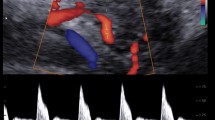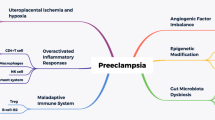Abstract
Background
Lung hypoplasia, pulmonary persistent hypertension of the newborn and its morphological changes are the main features in congenital diaphragmatic hernia (CDH). This study was undertaken to investigate if antenatal use of sildenafil and/or bosentan attenuates vascular remodeling, promotes branching, and improves alveolarization in experimental nitrofeninduced CDH.
Methods
Nitrofen (100 mg) was gavage-fed to pregnant rats at post conception day (PCD) 9 to induce CDH. The rats were randomized to 5 groups: 1) control; 2) nitrofen; 3) nitrofen+sildenafil 100 mg/kg per day at PCD 16–20; 4) nitrofen+bosentan 30 mg/kg per day, at PCD 16–20, and 5) nitrofen+bosentan+sildenafil, same doses and administration days. After cesarean delivery, the offsprings were sacrificed. The diaphragmatic defect and pulmonary hypoplasia were identified, and the lungs were dissected. Arterial wall thickness, bronchiolar density and alveolarization were assessed.
Results
The offsprings with CDH were characterized by severe pulmonary hypoplasia (lung weight-to-body weight ratio: 0.0263 [95% confidence interval (CI) 0.0242–0.0278)] in the nitrofen group versus 0.0385 (95% CI 0.0355–0.0424) in the control group (P=0.0001). Pulmonary arterial wall thickness was decreased to 3.0 (95% CI 2.8–3.7) μm in the nitrofen+sildenafil group versus 5.0 (95% CI 4.1–4.9) μm in the nitrofen group (P=0.02). Terminal bronchioles increased to 13.7 (95% CI 10.7–15.2) μm in the nitrofen+bosentan group in contrast to 8.7 (95% CI 7.2–9.4) μm in the nitrofen group (P=0.002). More significant differences (P=0.0001) were seen in terminal bronchioles in the nitrofen+sildenafil+bosentan group than in the nitrofen group [14.0 (95% CI 12.5–15.4) μm versus 8.5 (95% CI 7.1–9.3) μm]. Pulmonary arterial wall thickness was also decreased in the former group.
Conclusions
In this rat model, antenatal treatment with sildenafil attenuates vascular remodeling. Bosentan promotes the development of terminal bronchioles in nitrofen-induced CDH.
Similar content being viewed by others
References
Reiss I, Schaible T, van den Hout L, Capolupo I, Allegaert K, van Heijst A, et al. Standardized postnatal management of infants with congenital diaphragmatic hernia in Europe: the CDH EURO Consortium consensus. Neonatology 2010;98:354–364.
Stevens TP, van Wijngaarden E, Ackerman KG, Lally PA, Lally KP. Congenital Diaphragmatic Hernia Study Group. Timing of delivery and survival rates for infants with prenatal diagnoses of congenital diaphragmatic hernia. Pediatrics 2009;123:494–502.
Sluiter I, van de Ven CP, Wijnen RM, Tibboel D. Congenital diaphragmatic hernia: still a moving target. Semin Fetal Neonatal Med 2011;16:139–144.
Pober BR. Overview of epidemiology, genetics, birth defects, and chromosome abnormalities associated with CDH. Am J Med Genet C Semin Med Genet 2007;145C:158–171.
Lakshminrusimha S. The pulmonary circulation in neonatal respiratory failure. Clin Perinatol 2012;39:655–683.
Haroon J, Chamberlain RS. An evidence-based review of the current treatment of congenital diaphragmatic hernia. Clin Pediatr (Phila) 2013;52:115–124.
van den Hout L, Sluiter I, Gischler S, De Klein A, Rottier R, Ijsselstijn H, et al. Can we improve outcome of congenital diaphragmatic hernia? Pediatr Surg Int 2009;25:733–743.
Safavi A, Lin Y, Skarsgard ED, Canadian Pediatric Surgery Network. Perinatal management of congenital diaphragmatic hernia: when and how should babies be delivered? Results from the Canadian Pediatric Surgery Network. J Pediatr Surg 2010;45:2334–2339.
Garne E, Haeusler M, Barisic I, Gjergja R, Stoll C, Clementi M, et al. Congenital diaphragmatic hernia: evaluation of prenatal diagnosis in 20 European regions. Ultrasound Obstet Gynecol 2002;19:329–333.
Rodrigues HC, Deprest J, v d Berg PP. When referring physicians and researchers disagree on equipoise: the TOTAL trial experience. Prenat Diagn 2011;31:589–594.
Lazar DA, Cass DL, Rodriguez MA, Hassan SF, Cassady CI, Johnson YR, et al. Impact of prenatal evaluation and protocolbased perinatal management on congenital diaphragmatic hernia outcomes. J Pediatr Surg 2011;46:808–813.
Claus F, Sandaite I, DeKoninck P, Moreno O, Cruz Martinez R, Van Mieghem T, et al. Prenatal anatomical imaging in fetuses with congenital diaphragmatic hernia. Fetal Diagn Ther 2011;29:88–100.
Deprest JA, Flemmer AW, Gratacos E, Nicolaides K. Antenatal prediction of lung volume and in-utero treatment by fetal endoscopic tracheal occlusion in severe isolated congenital diaphragmatic hernia. Semin Fetal Neonatal Med 2009;14:8–13.
Gallindo RM, Gonçalves FL, Barreto CT, Schmidt AF, Pereira LA, Sbragia L. Evaluation of histological changes after tracheal occlusion at different gestational ages in a fetal rat model. Clinics (Sao Paulo) 2013;68:59–63.
Ghanta S, Leeman KT, Christou H. An update on pharmacologic approaches to bronchopulmonary dysplasia. Semin Perinatol 2013;37:115–123.
Porta NF, Steinhorn RH. Pulmonary vasodilator therapy in the NICU: inhaled nitric oxide, sildenafil, and other pulmonary vasodilating agents. Clin Perinatol 2012;39:149–164.
Ladha F, Bonnet S, Eaton F, Hashimoto K, Korbutt G, Thébaud B. Sildenafil improves alveolar growth and pulmonary hypertension in hyperoxia-induced lung injury. Am J Respir Crit Care Med 2005;172:750–756.
Galié N, Manes A, Branzi A. The endothelin system in pulmonary arterial hypertension. Cardiovasc Res 2004;61:227–237.
Keijzer R, Puri P. Congenital diaphragmatic hernia. Semin Pediatr Surg 2010;19:180–185.
Luong C, Rey-Perra J, Vadivel A, Gilmour G, Sauve Y, Koonen D, et al. Antenatal sildenafil treatment attenuates pulmonary hypertension in experimental congenital diaphragmatic hernia. Circulation 2011;123:2120–2131.
Nakazawa N, Montedonico S, Takayasu H, Paradisi F, Puri P. Disturbance of retinol transportation causes nitrofen-induced hypoplastic lung. J Pediatr Surg 2007;42:345–349.
Mey J, Babiuk RP, Clugston R, Zhang W, Greer JJ. Retinal dehydrogenase-2 is inhibited by compounds that induce congenital diaphragmatic hernias in rodents. Am J Pathol 2003;162:673–679.
Cooney TP, Thurlbeck WM. The radial alveolar count method of Emery and Mithal: a reappraisal 1—postnatal lung growth. Thorax 1982;37:572–579.
Matturri L, Lavezzi AM, Minoli I, Ottaviani G, Rubino B, Cappellini A, et al. Association between pulmonary hypoplasia and hypoplasia of arcuate nucleus in stillbirth. J Perinatol 2003;23:328–332.
Grover TR, Parker TA, Balasubramaniam V, Markham NE, Abman SH. Pulmonary hypertension impairs alveolarization and reduces lung growth in the ovine fetus. Am J Physiol Lung Cell Mol Physiol 2005;288:L648–654.
Tschanz SA, Makanya AN, Haenni B, Burri PH. Effects of neonatal high-dose short-term glucocorticoid treatment on the lung: a morphologic and morphometric study in the rat. Pediatr Res 2003;53:72–80.
Coppola CP, Gosche JR. Oxygen-induced vasodilation is blunted in pulmonary arterioles from fetal rats with nitrofen-induced congenital diaphragmatic hernia. J Pediatr Surg 2001;36:593–597.
Wilcox DT, Irish MS, Holm BA, Glick PL. Animal models in congenital diaphragmatic hernia. Clin Perinatol 1996;23:813–822.
Montedonico S, Nakazawa N, Puri P. Congenital diaphragmatic hernia and retinoids: searching for an etiology. Pediatr Surg Int 2008;24:755–761.
Sakai M, Unemoto K, Solari V, Puri P. Decreased expression of voltage-gated K+ channels in pulmonary artery smooth muscles cells in nitrofen-induced congenital diaphragmatic hernia in rats. Pediatr Surg Int 2004;20:192–196.
Ringman A, Zelenina M, Eklöf AC, Aperia A, Frenckner B. NKCC-1 and ENaC are down-regulated in nitrofen-induced hypoplastic lungs with congenital diaphragmatic hernia. Pediatr Surg Int 2008;24:993–1000.
Roubliova X, Verbeken E, Wu J, Yamamoto H, Lerut T, Tibboel D, et al. Pulmonary vascular morphology in a fetal rabbit model for congenital diaphragmatic hernia. J Pediatr Surg 2004;39:1066–1072.
Wharton J, Strange JW, Møller GM, Growcott EJ, Ren X, Franklyn AP, et al. Antiproliferative effects of phosphodiesterase type 5 inhibition in human pulmonary artery cells. Am J Respir Crit Care Med 2005;172:105–113.
Rocha GM, Bianchi RF, Severo M, Rodrigues MM, Baptista MJ, Correia-Pinto J, et al. Congenital diaphragmatic hernia — the neonatal period (part I). Eur J Pediatr Surg 2008;18:219–223.
Shiyanagi S, Okazaki T, Shoji H, Shimizu T, Tanaka T, Takeda S, et al. Management of pulmonary hypertension in congenital diaphragmatic hernia: nitric oxide with prostaglandin-E1 versus nitric oxide alone. Pediatr Surg Int 2008;24:1101–1104.
Morikawa N, Kuroda T, Honna T, Kitano Y, Takayasu H, Ito Y, et al. The impact of strict infection control on survival rate of prenatally diagnosed isolated congenital diaphragmatic hernia. Pediatr Surg Int 2008;24:1105–1109.
Karamanoukian HL, Glick PL, Zayek M, Steinhorn RH, Zwass MS, Fineman JR, et al. Inhaled nitric oxide in congenital hypoplasia of the lungs due to diaphragmatic hernia or oligohydramnios. Pediatrics 1994;94:715–718.
American Academy of Pediatrics. Committee on Fetus and Newborn. Use of inhaled nitric oxide. Pediatrics 2000;106:344–345.
Montedonico S, Sugimoto K, Felle P, Bannigan J, Puri P. Prenatal treatment with retinoic acid promotes pulmonary alveologenesis in the nitrofen model of congenital diaphragmatic hernia. J Pediatr Surg 2008;43:500–507.
Baird R, Khan N, Flageole H, Anselmo M, Puligandla P, Laberge JM. The effect of tracheal occlusion on lung branching in the rat nitrofen CDH model. J Surg Res 2008;148:224–229.
Shim JW, Chang YS, Park WS. Intratracheal administration of endotoxin attenuates hyperoxia-induced lung injury in neonatal rats. Yonsei Med J 2008;49:144–150.
Grisaru-Granovsky S, Rabinowitz R, Ioscovich A, Elstein D, Schimmel MS. Congenital diaphragmatic hernia: review of the literature in reflection of unresolved dilemmas. Acta Paediatr 2009;98:1874–1881.
Author information
Authors and Affiliations
Corresponding author
Rights and permissions
About this article
Cite this article
Lemus-Varela, M.d.L., Soliz, A., Gómez-Meda, B.C. et al. Antenatal use of bosentan and/or sildenafil attenuates pulmonary features in rats with congenital diaphragmatic hernia. World J Pediatr 10, 354–359 (2014). https://doi.org/10.1007/s12519-014-0512-y
Received:
Accepted:
Published:
Issue Date:
DOI: https://doi.org/10.1007/s12519-014-0512-y




